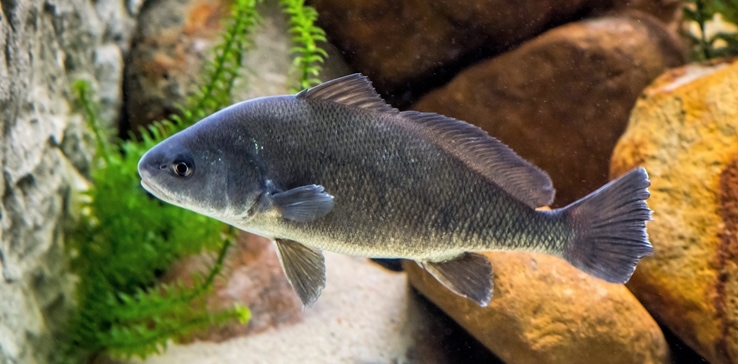The freshwater drum is a common fish in most waterways throughout the central and eastern United States. Though most anglers don’t head out in the morning targeting these fish, many have had memorable encounters with them. One encounter in particular would produce the largest freshwater drum caught in Pennsylvania — a record that would stand uncontested for decades.
In this article, we’ll learn about the general characteristics of the freshwater drum: their appearance, their diet, and where they tend to live. Then, to give some context for the state record catch, we’ll find out how big these fish get on average. We’ll also compare the Pennsylvania record drum to the largest one ever caught in North America.
About the Freshwater Drum (Aplodinotus grunniens)
Also known by such strange names as the gasper goo, gou, grunter, and gobble gobble, the freshwater drum is an interesting animal, to say the least. Below, we’ll talk about where these fish live, how big they can get, and some of the traits and behaviors that make them unique!
Appearance and Behavior
The freshwater drum is easily recognized by its humped back and long, notched dorsal fin. The front half of the fin, when raised, is shaped like a sail while the rear portion is more oblong and rounded overall. These fish have very large caudal fins and deep, strong bodies that allow them to navigate both slow-moving water and strong river flows. Freshwater drum also exhibit a range of coloration. Depending on the clarity of the water, their scales may be silvery and iridescent or brassy and brown — an adaptation that allows them to hide from predator and prey alike.

Depending on the clarity of their environment, freshwater drums may develop different coloration. In clearer water, they tend to be gray or silver.
©U.S. Geological Survey / Public Domain – Original / License
More distinctive than their appearance, these fish are quite easy to identify by the unique sounds they produce. Freshwater drums have a special set of muscles that they can use to produce percussive sounds. As they vibrate these muscles against the walls of their swim bladders, the fish emit a distinctive thumping or buzzing noise, much like a drum. The fish can be quite loud and rhythmic, especially in large groups, earning them their common name. Check out this audio clip to hear a chorus of freshwater drum vocalizing in the Seneca Canal!
Average Size
To start its life, the freshwater drum emerges from its free-floating egg at the surface of its home waterway. At this stage, the fish is only about an eighth of an inch long and is very susceptible to predation. Within its first year, however, it quickly outgrows the mouths of its aquatic predators.
Those that survive their early years tend to reach weights between 5 and 15 pounds, with females growing larger than males. Some can grow much larger than that, however! In the right conditions, freshwater drum can grow to weigh well over 30 pounds. The largest specimen on record, caught in Tennessee’s Nickajack Lake, tipped the scales at a whopping 54 pounds, 8 ounces!

In murky water, freshwater drum take on a coppery, brown, or brassy appearance.
©RLS Photo/Shutterstock.com
Though they aren’t generally known for being the largest of fish, their impressive maximum sizes may not come as much surprise when you consider their longevity. Freshwater drum tend to be very long-lived fish. Impressively, some drum on record have lived more than 40 years. Today, however, they live between 6 and 12 years on average, reaching sexual maturity in their fifth or sixth year.
Diet
During the summer months, freshwater drum migrate further up in the water column to spawn. There, where they are unable to access much of their usual fare, their diet shifts toward small mid-water fish like shad, minnows, and young sunfish.
For most of the year, however, these fish are benthic zone feeders. This means that they seek out their prey primarily at the bottom of the waterway. They will eat anything from larval insects and worms to crawfish, snails, and appropriately sized freshwater bivalves. While they will also feed on smaller fish when available, their strong jaws and robust pharyngeal teeth are especially good at crushing hard exoskeletons.

These fish have a special set of pharyngeal teeth that allow them to easily crush and grind hard exoskeletons. Mollusks beware!
Habitat and Range
As its name suggests, the freshwater drum inhabits exclusively freshwater ecosystems. This isn’t limiting, however, as it enjoys one of the widest native ranges of any North American fish species. These fish appear in waterways from the Appalachian Mountains in the east to the Rockies in the west, and from the Hudson Bay area to as far south as Guatemala! Due to the introduction by humans, the freshwater drum can also be found outside of this range. Populations have appeared past the Appalachian boundary in eastern New York, Pennsylvania, and Virginia. They have also shown up in Lake Superior to the north and in various waterways near the western extent of their range.

The freshwater drum enjoys a massive native range, shown in yellow on the map above. The largest freshwater drum caught in Pennsylvania inhabited the western part of the state, well within its native range.
©U.S. Geological Survey / Public Domain – Original / License
If you’re looking to catch freshwater drum, you’ll have a shot in clear, slow-moving waterways with smooth, sandy, or gravelly bottoms. During their mating period in the summertime, they’re more likely to appear higher in the water column. For the rest of the year, your best bet is to target them along the bottom of the waterway.
How Big Was the Pennsylvania Record Freshwater Drum?
Though the species doesn’t get particularly large in the Northeast, the Pennsylvania record freshwater drum was still an impressive specimen. In 1994, angler Tim Rogers reeled in a 19-pound, 14-ounce drum in southwest Pennsylvania’s Monongahela River. Though there may be a larger drum hiding somewhere in the state, his fish has held the state record for nearly 30 consecutive years!
The photo featured at the top of this post is © RLS Photo/Shutterstock.com
Thank you for reading! Have some feedback for us? Contact the AZ Animals editorial team.







